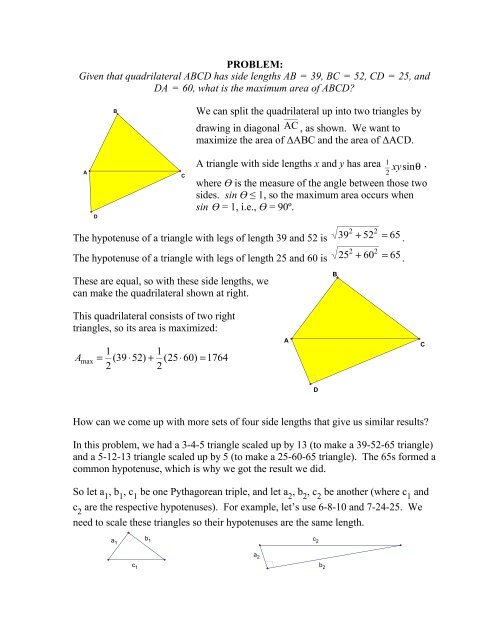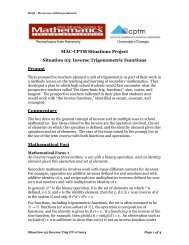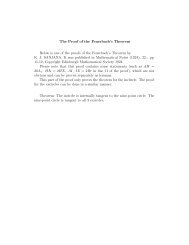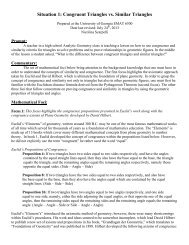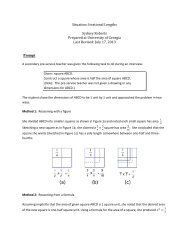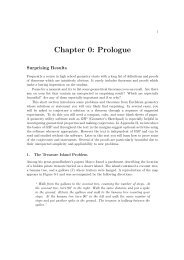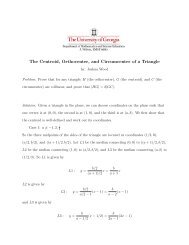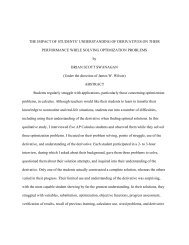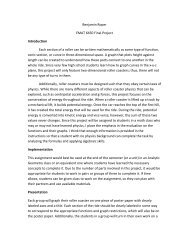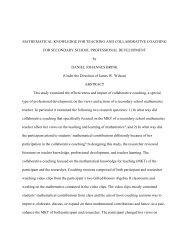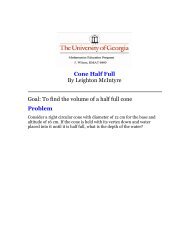problem & solution
problem & solution
problem & solution
Create successful ePaper yourself
Turn your PDF publications into a flip-book with our unique Google optimized e-Paper software.
PROBLEM:Given that quadrilateral ABCD has side lengths AB = 39, BC = 52, CD = 25, andDA = 60, what is the maximum area of ABCD?BWe can split the quadrilateral up into two triangles bydrawing in diagonal AC , as shown. We want tomaximize the area of ΔABC and the area of ΔACD.ADCA triangle with side lengths x and y has area1 xy sinθ,where Ө is the measure of the angle between those twosides. sin Ө ≤ 1, so the maximum area occurs whensin Ө = 1, i.e., Ө = 90º.2The hypotenuse of a triangle with legs of length 39 and 52 is 39 + 52 = 65 .The hypotenuse of a triangle with legs of length 25 and 60 is 25 + 60 = 65 .2222These are equal, so with these side lengths, wecan make the quadrilateral shown at right.BThis quadrilateral consists of two righttriangles, so its area is maximized:1 1Amax = (39 ⋅52)+ (25⋅60) = 17642 2ACDHow can we come up with more sets of four side lengths that give us similar results?In this <strong>problem</strong>, we had a 3-4-5 triangle scaled up by 13 (to make a 39-52-65 triangle)and a 5-12-13 triangle scaled up by 5 (to make a 25-60-65 triangle). The 65s formed acommon hypotenuse, which is why we got the result we did.So let a 1, b 1, c 1be one Pythagorean triple, and let a 2, b 2, c 2be another (where c 1andc 2are the respective hypotenuses). For example, let’s use 6-8-10 and 7-24-25. Weneed to scale these triangles so their hypotenuses are the same length.a1 b 1c 2a 2c 1 b 2
Let m be the least common multiple of c 1andc 2. We want to scale the triangles up so theirhypotenuses are m. We need to scale the first bya factor ofm and the second by a factor ofm .c 1c2For our example, m = LCM(10,25) = 50, so ourscaled-up triangles are (6-8-10)(5) = 30-40-50and (7-24-25)(2) = 14-48-50.mNow we have two right triangles with a common hypotenuse.We can scale this by any factor k. So if k is acounting number, then a quadrilateral ABCDwith side lengthsAB =⎛ m ⎞k a ⎜⎟ , BC =⎛ ⎞k b1⎝ c ⎜m⎟ ,1 ⎠1 ⎝ c 1 ⎠CD =⎛ m ⎞k a ⎜⎟ , and DA =⎛ m ⎞kb 2⎝ c ⎜⎟2 ⎠2 ⎝ c 2 ⎠will have properties similar to the 39-52-25-60quadrilateral we just dealt with.For our example, let’s let k = 2. Then our side lengths are AB = 60, BC = 80,CD = 28, and DA = 96.Try these side lengths (or some of your own) in the included GSP file to see if theywork too.


